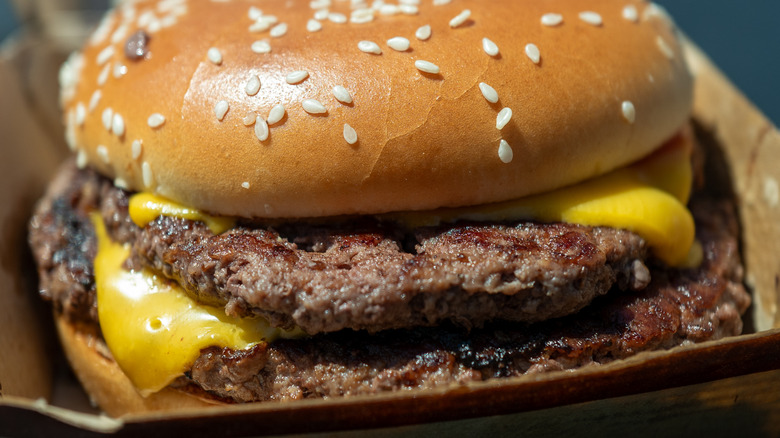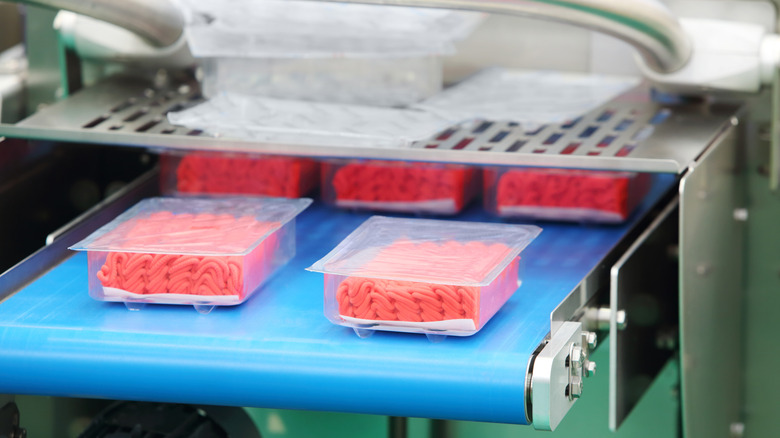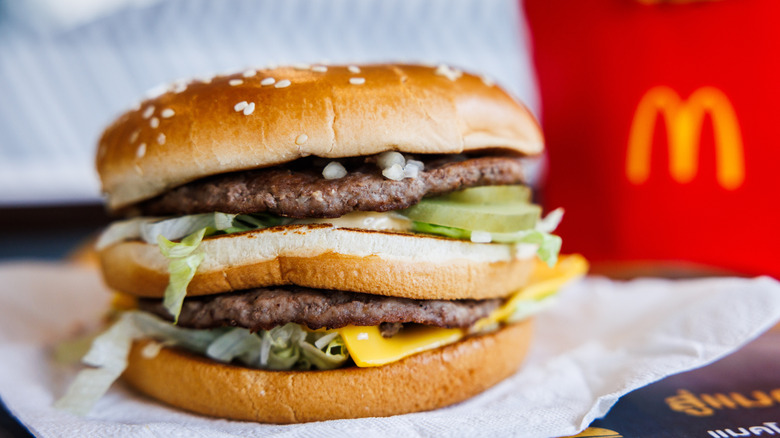What Was The Deal With McDonald's Using 'Pink Slime' For Its Beef?
McDonald's made a startling announcement in 2012, stating it would no longer be serving burgers made from "lean beef trimmings treated with ammonia" in America. A concise statement was posted on their website, explaining that McDonald's USA uses 100% beef without preservatives, fillers, or extenders. The decision set a new standard; company representatives said prior to 2012, your favorite classic McDonald's hamburger was likely made with those ammonia-treated beef trimmings, which quickly became known as "pink slime." But McDonald's didn't coin that phrase — someone else was making pink slime infamous.
Celebrity chef Jamie Oliver started talking about pink slime in April 2011 on his TV show "Jamie Oliver's Food Revolution". Oliver shed light on the process of machine-treating meat, drawing attention to the many unappetizing qualities of the ammonia-treated meat. He questioned the wisdom of eating anything that contained pink slime and called for its removal from school lunches and fast food menus, particularly McDonald's. A few months later, McDonald's announced its move away from using the meat filler in its hamburgers. At the time, then-senior supply chain officer Todd Bacon told the Daily Mail the decision "was not related to any particular event, but rather to support our effort to align our global beef raw material standards."
What is pink slime and is it really that bad?
Pink slime refers to small cuts of fat and lean beef treated with ammonium-hydroxide and processed until they melt together into a paste. This paste can be formed into any kind of meat-like product. It is similar to mechanically separated meat and mechanically separated chicken, all ground and processed using a centrifuge. It's made by heating trimmings, fat slices, and discarded chunks of beef after butchering until they are liquified. Then, the mixture is spun in a centrifuge, separating the fat and the lean beef. The whole thing is then treated with ammonia gas to kill bacteria. Next, the lean part is collected and becomes pink slime. McDonald's drew attention for serving mechanically treated meat filler fogged with ammonium-hydroxide gas, but it's not the only company that has used pink slime. Pink slime is added to hamburger meat in supermarkets, fast food joints, and other restaurants, particularly to meat that is 90% lean or above.
Though it created an outcry from the public, some in the industry say lean finely textured beef (LFTB) isn't all that bad. It's 100% beef, even though it's been pushed through a mechanical process, and is still packed with nutrients –- just minus the fat. They claim the ammonia treatment isn't unhealthy either. It results in a small amount of residual ammonium that is processed in the human body along with the ammonia that is naturally occurring.
Does McDonald's still use mechanically separated meat or LFTB?
McDonald's doesn't use any kind of mechanically separated meat in the USA anymore. The company stopped using mechanically separated chicken in 2011, just before discontinuing the use of lean finely textured beef, or pink slime, in their burgers. Now, burgers are 100% pure beef with a little salt and pepper, and only 100% chicken breast is used for all of their chicken menu items. The sausage for breakfast sandwiches and platters is made from 100% ground sausage with water and seasoning. Even the coveted and often-missing-from-the-menu McRib is made completely of meat: ground pork shoulder, according to McDonald's.
Concerns around the quality of the meat at the Golden Arches seem to have quieted, though McDonald's has had its problems in other areas. A lethal E.coli outbreak stemming from sliced onions at McDonald's in October 2024 caused infections in several states and one death. The corporation apologized and did what it could to make it right, immediately discontinuing the contaminated onions. Once everything was back up to standard, McDonald's corporate office took to reassuring customers it was safe to return to their beloved burgers, or to drop by for the cult classic that had just reappeared on the menu: a McRib with a saucy surprise on the side.


